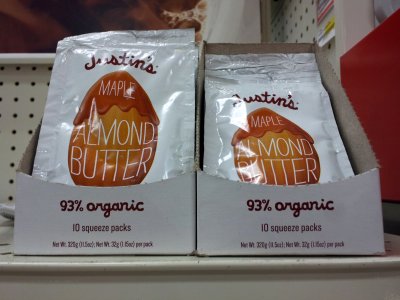So what’s the other seven percent, then?
< 1 minute read
February 14, 2012, 11:46 PM
So I was perusing the Target store in Wheaton this evening, and ran across this:
So if it’s “93% organic” as the manufacturer of Justin’s Maple Almond Butter claims, what’s in the other seven percent that’s not? Remember that USDA regulates the use of the word “organic” when it comes to food. So since they’re not carrying the organic certification mark, one would presume that it’s not really “organic” food. So why even bring it up, then? That seems odd to say the least.
The way I see it, I’m sure that many products have some percentage of organic content (except maybe not the things coming out of Monsanto facilities, but that’s a different Journal entry entirely). But why advertise that you’re only partly organic? Go the whole way and get the certification mark, or don’t mention the organicity of your product at all. In my eyes, they just drew my attention to the other seven percent of it that isn’t organic. What is in that seven percent that fails the organic test? Why does it fail the organic test? Why is it in this otherwise organic almond butter? Until I saw that line, I thought it was an interesting product on the shelves of Target. Then I saw the line, and was a bit turned off by it.
If nothing else, I now know a brand of nut butter that I’m definitely not recommending to my friends.
Song: Spit Takes: Advanced. Try and get through this one without laughing.
Quote: (I really don't have anything to say here, but this build of the Journal doesn't allow me to omit fields without leaving awkward blank fields lying around, therefore...)
Categories: Food and drink, Products, Target










